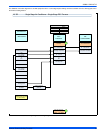
364861-UIM-H-0712
Johnson Controls Unitary Products 17
The condensate will flow to the drain better if an open stand pipe is
installed in the drain line. See Figure 23.
If evaporator coil or humidifier drains are combined with the furnace
drain, then the open stand pipe could be raised higher, above the 5”
minimum.
CONDENSATE DRAIN TERMINATION
A condensate sump pump MUST be used if required by local codes, or
if no indoor floor drain is available. The condensate sump pump must
be approved for use with acidic condensate.
The furnace, evaporator coil, and humidifier drains may be combined
and drained together. The evaporator coil drain may have an exter-
nal, field-supplied trap prior to the furnace drain connection to prevent
conditioned air leakage. All drain connections (furnace, evaporator
coil, or humidifier) must be terminated into an open or vented drain as
close to the respective equipment as possible. Regular maintenance
is required on condensate drainage system.
Condensate must be disposed of properly. Follow local plumbing
or wastewater codes. The drain line must maintain a 1/4" per foot (20
mm/m) downward slope to the drain.
If an external vent tee is being installed, then it must have its own
condensate trap before it is disposed into an open or vented drain.
This is not to be considered as a second trap as referenced else-
where in this document.
FIGURE 23: Typical. Condensate drain, vertical installation
A loop has been added to the pressure switch vacuum hose. How-
ever, ensure that all pressure switch hoses are routed such that they
prevent any condensate from entering the pressure switch.
To Open Or
Vented Drain
Tee
5” Min.
Open Stand Pipe
(Anti-siphon air vent)
NOTICE
It is possible for condensation to form inside the combustion air
(intake) pipe in the summer months if significant length of combustion
air pipe passes through conditioned space. This problem can be
averted by the addition of a simple drain tee, or a drain tee with a
drain on the combustion air pipe as close to the furnace as possible,
as shown in Figure 24. This is true for all long horizontal venting in
any furnace configuration. This will prevent the condensate from
entering the furnace.
FIGURE 24: Typical. Combustion Pipe Drain Tee
DO NOT terminate the condensate drain in a chimney, or where the
drain line may freeze. If the drain line will be exposed to temperatures
below freezing, adequate measures must be taken to prevent the
drain line from freezing. Failure to provide proper protection from
freezing can result in improper operation or damage to the equipment
and possible property damage. When exposed to temperatures
below freezing, use of a 3 to 6 watt per foot at 115 VAC, 40°F (4.4°C)
self-regulating, shielded and waterproof heat tape is recommended
on the drain line outside the furnace.
DO NOT trap the drain line at any other location than at the conden-
sate drain trap supplied with the furnace.
Liquid anti-freeze will cause damage to internal plastic parts of this
furnace. DO NOT attempt to winterize the furnace using liquid
anti-freeze.
Connect to Drain
Trap
Combustion Air Pipe
Tee with Drain Trap
Exhaust Pipe


















